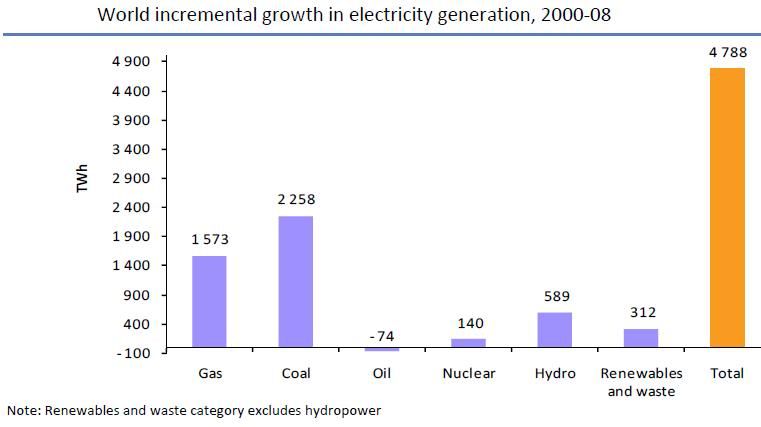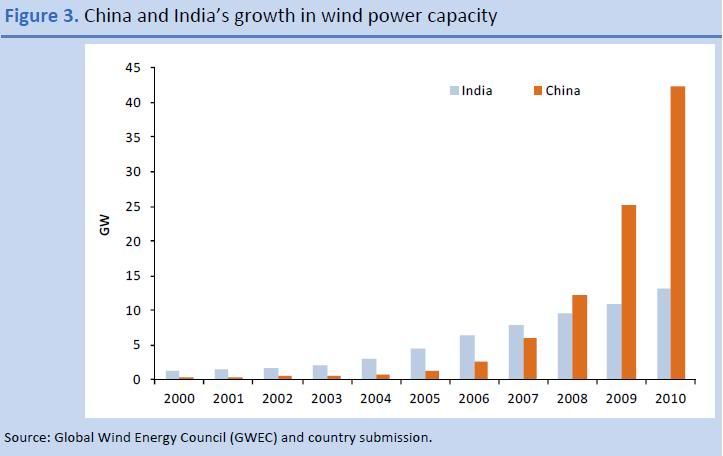
The world continues to rely heavily on coal as an energy source; for the past decade, coal has met 47% of new electricity demand globally. There is also a growing difference between the use of coal for power generation between OECD and non‐OECD regions. Though contributions from hydropower, nuclear and natural gas use are increasing, growth in energy demand in these countries is largely being fed by coal. By contrast, in OECD countries new power demand is being met by natural gas and new renewable energy, especially wind power; and coal is contributing substantially less.
- Clean energy technologies are making clear progress globally, but fossil fuels continue to outpace them. More aggressive clean energy policies are required, including the removal of fossil fuel subsidies and implementation of transparent, predictable and adaptive incentives for cleaner, more efficient energy options.
- Thanks to favourable policy support, solar PV and windpower are achieving strong growth. However, achieving sustainable energy goals will require a doubling of all renewable energy use by 2020. There are also signs that policy support is weakening due to government austerity plans. Instead of eliminating successful policies, governments need to put in place dynamic schemes that respond to technology markets.
- For the past decade, coal has been the fastest‐growing global energy source, meeting 47% of new electricity demand. Extensive deployment of CCS is critical to achieve climate change goals: around 100 large‐scale projects are needed by 2020, but countries must accelerate their policy and funding support for the large‐scale CCS demonstrations.
- Progress has been made to transform the market for some key energy‐efficient products, including compact fluorescent light bulbs. However, in the buildings and industry sectors, significant under‐investment remains, resulting from an array of market financial, information, institutional and technical barriers. Much more policy effort is needed to capture the nearterm profitable and low cost energy savings opportunities.
- Biofuels have shown steady growth, but still only represent 3% of global road transport fuel consumption. A sound policy framework is required to ensure the sustainable growth of biofuel production by ten‐fold to reach climate change targets in 2050. Commercialisation of advanced, sustainable biofuels will be particularly critical to meet targets, and will require significant expansion of production capacity.
- Electric vehicles are poised to take off. Major economies have announced targets that together would reach about 7 million vehicle sales per year by 2020. If achieved, this will result in over 20 million electric vehicles on the road by that year, taking into account all sales over the next 9 years. However, this will only account for about 2% of light‐duty vehicle stocks worldwide; continued strong growth after 2020 will be important to ensure market transformation. Fuel economy of conventional light‐duty vehicles has also been improving recently, but will need to improve faster to achieve a global target of 50% improvement by 2030 compared to 2005 levels.
- While nuclear capacity has remained nearly flat for the past decade, countries are currently constructing 66 nuclear reactors that should add 60 Gigawatts by 2015. However, the recent earthquake in Japan and resulting damage have led countries to review nuclear safety and investments across the board. As a result, nuclear expansion is likely to be slower than planned.
- An increased level of systems thinking is needed to integrate the broad range of individual clean energy technologies into the energy system. Increased attention and resources are required to expand smart grid pilot projects on a regional level.
- International collaboration is key to ensuring that momentum is maintained and gaps are addressed. The Clean Energy Ministerial offers an unique opportunity to accelerate technology deployment through government and corporate pledges and tracking progress toward shared global energy goals.

China began installing wind power capacity in 2005, but has since become the world’s largest domestic wind market, achieving three times the installed capacity in India (or ten times the capacity in Denmark) in just give years. As in Denmark and India, China created strong incentives and drivers for private investment through a comprehensive mix of support.
~~~~~~~
Note that there is much more of interest in this report. The above are just a sampling of highlights.
source: IEA 2011 Clean Energy Progress Report